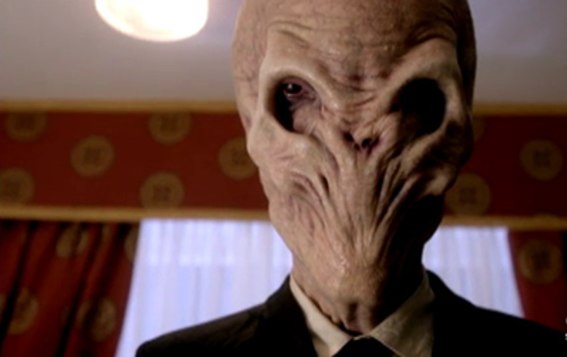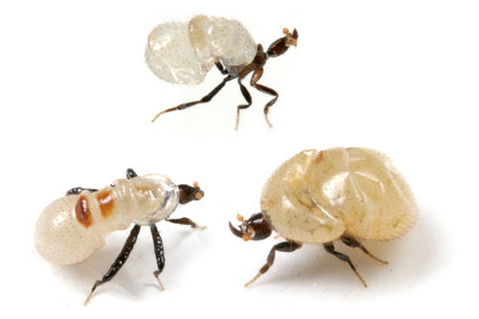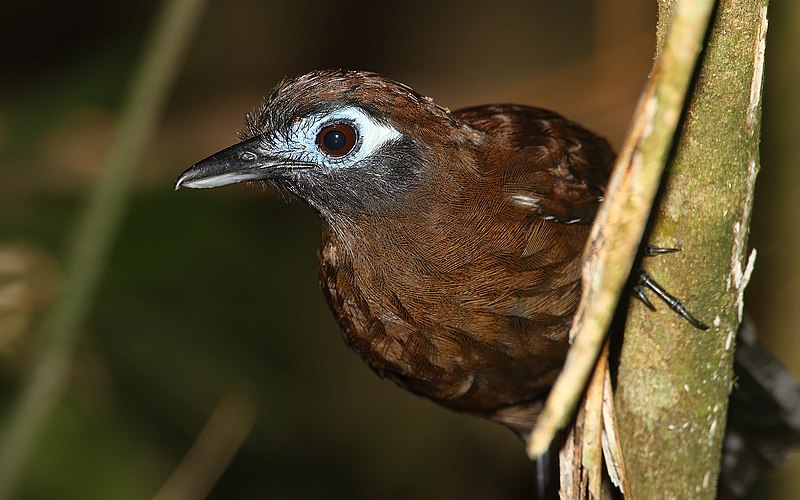 |
| "Silence, Doctor...silence will fall." |
In essence, the Silence are social parasites of humanity. To my knowledge, in reality the syndrome is unknown among mammals (although right-wing pundits might debate the point), but a fantastical diversity of specialist social parasites haunt eusocial insects: usually termites or ants—and respectively classed as termitophiles or myrmecophiles. Members of the latter category have been identified in 95 arthropod families (Hölldobler & Wilson, 1990). (For various reasons, the entomofauna of social wasps' and bees' abodes is far less rich; Wilson, 1971.)
| Argentinean Microdon sp. photographed by Alex Wild alongside adults of its prey (Linepithema oblongum) |
 |
| Yet another invasive scourge of apiculture: the small hive beetle (Aethina tumida); portrait by Alex Wild |
 |
| Clockwise, top-to-bottom-left: Clitelloxenia formosana, Horologiphora sinensis and Pseudotermitoxenia nitobei |
 |
| Lateral and dorsal views of C. ovambolambicus, drawn by Ivanov Petrov (after Kistner, 1968) |
 |
| A paussine from Mozambique (portrait by the great Piotr Naskrecki) |
 |
| Left (top-to-bottom): Labidopullus ashei, Pseudomimeciton sp.; right (""): Bayeria vespa, Ecitophya bicolor |
 |
| Female immaculate antbird (Myrmeciza immaculata: Thamnophilidae), an obligate army-ant follower |
*Yes, this is the singular form of the species' name ("Silence" is plural). So much for grammar...
†Following the completion of a holometabolous insect's metamorphosis.
____________________________________________________________
Chatzimanolis, S.; Grimaldi, D. A.; Engel, M. S.; and Fraser, N. C. (2012). Leehermania prorova, the earliest staphyliniform beetle, from the Late Triassic of Virginia (Coleoptera: Staphylinidae) [electronic version]. American Museum Novitates, 3761, 1-28. Retrieved 10/22/13 from http://www.bioone.org/doi/abs/10.1206/3761.2
Cheng, X. and Thompson, F. C. (2008). A generic conspectus of the Microdontinae (Diptera: Syrphidae) with the description of two new genera from Africa [electronic version]. Zootaxa, 1879, 21-48. Retrieved 10/13/13 from http://mapress.com/zootaxa/2008/f/zt01879p048.pdf
Cini, A.; Bruschini, C.; Signorotti, L.; Pontieri, L.; Turillazzi, S.; and Cervo, R. (2011). The chemical basis of host nest detection and chemical integration in a cuckoo paper wasp [electronic version]. The Journal of Experimental Biology, 214, 3,698-3,703. Retrieved 10/13/13 from http://jeb.biologists.org/content/214/21/3698.full.pdf
Disney, R. H. L. and Kistner, D. H. (1995). Revision of the Afrotropical Termitoxeniinae (Diptera, Phoridae). Sociobiology, 26, 115-225.
Ellis, J. D. and Hepburn, H. R. (2006). An ecological digest of the small hive beetle (Aethina tumida), a symbiont of honeybee colonies (Apis mellifera) [electronic version]. Insectes Sociaux, 53(2006), 8-19. Retrieved 10/21/13 from http://download.springer.com/static/pdf/26/art%253A10.1007%252Fs00040-005-0851-8.pdf?auth66=1382488061_9d3d9c81afb74737d07d3b7ae4760b5b&ext=.pdf
Henderson, G. and Akre, R. D. (1986). Biology of the myrmecophilous cricket, Myrmecophila manni, Orthoptera: Gryllidae. Journal of the Kansas Entomological Society, 59(3), 454-467.
Hlaváč, P. and Janda, M. (2009). Leptogenopapus mirabilis, a new genus and species of Lomechusini (Coleoptera: Staphylinidae, Aleocharinae) from Papua New Guinea associated with ants of the genus Leptogenys Roger. Zootaxa, 2062, 57-64. Retrieved 10/28/13 from http://www.mapress.com/zootaxa/2009/f/zt02062p064.pdf
Howard, R. W.; McDaniel, C. A.; and Blomquist, G. J. (1980). Chemical mimicry as an integrating mechanism: cuticular hydrocarbons of a termitophile and its host [electronic version]. Science, 210(4468), 431-433. Retrieved 10/21/13 from http://www.scopus.com/record/display.url?eid=2-s2.0-0002077863&origin=inward&txGid=DD30CF48A6134A786FE0D182653E665A.WeLimyRvBMk2ky9SFKc8Q%3a1
Hölldobler, B. and Wilson, E. O. (1990). The Ants. Cambridge: the Belknap University Press of Harvard University Press.
Jacobson, H. R. and Kistner, D. H. (1991). Cladistic study, taxonomic restructuring, and revision of the myrmecophilous tribe Leptanillophilini with comments on its evolution and host relationships (Coleoptera: Staphylinidae: Hymenoptera: Formicidae) [electronic version]. Sociobiology, 18(1), 1-150. Retrieved 10/23/13 from http://www.ots.ac.cr/bnbt/27035.html
Kistner, D. H. (1968). Revision of the African species of the termitophilous tribe Corotocini (Coleoptera: Staphylinidae). I. A new genus and species from Ovamboland and its zoogeographic significance. Journal of the New York Entomological Society, 76(3), 213-221. Retrieved 10/13/13 from http://www.jstor.org/stable/25006122?seq=1
Kistner, D. H. (1982). The social insects' bestiary. In Herman, H. R. (ed.) (pp. 1-244): Social Insects (vol. III). New York: Academic Press.
Kistner, D. H. (1990). The integration of foreign insects into termite societies or why do termites tolerate foreign insects in their societies? Sociobiology, 17, 191-215.
Kistner, D. H. and Jacobson, H. R. (1990). Cladistic analysis and taxonomic revision of the ecitophilous tribe Ecitocharini with studies of their behaviour and evolution (Coleoptera, Staphylinidae, Aleocharinae). Sociobiology, 17, 333-480.
Kreuter, K. R.; Francke, W. and Ayasse, M. (2010). Specialist Bombus vestalis and generalist Bombus bohemicus use different odour cues to find their host Bombus terrestris. Animal Behavior, 80, 297-302.
Mergelsberg, O. (1935). Über die postimaginale Entwicklung (Physogastrie) und der Hermaphroditismus bei afrikanischen Termitoxenien (Dipt.). Zoologische Jahrbuch (Anatomischen), 60, 345-398.
Maruyama, M.; Komatsu, T.; and Disney, R. H. L. (2011). Discovery of the termitophilous subfamily Termitoxeniinae (Diptera: Phoridae) in Japan, with a description of a new genus and species. Entomological Science, 14, 75-81. Retrieved 10/13/13 from http://onlinelibrary.wiley.com/doi/10.1111/j.1479-8298.2010.00409.x/pdf
Mynhardt, G. (2013). Declassifying myrmecophily in the Coleoptera to promote the study of ant-beetle symbioses. Psyche, 2013(2013), 1-8. Retrieved 10/21/13 from http://www.hindawi.com/journals/psyche/2013/696401/#B20
Newton, A. F. and Thayer, M. K. (1995). Protopselaphinae new subfamily for Protopselaphus new genus from Malaysia, with a phylogenetic analysis and review of the omaliine group of Staphylinidae including Pselaphidae (Coleoptera). In Pakaluk, J. and Slipinski, S. A. (eds.) (pp. 219-320): Biology, Phylogeny and Classification of the Coleoptera: Papers Celebrating the 80th Birthday of Roy A. Crowson. Warsaw: Muzeum i Instytut Zoologii PAN.
Newton, A. F.; Thayer, M. K.; Ashe, J. S.; and Chandler, D. S. (2002). Staphylinidae Latreille, 1802. In Arnett, R. J. and Thomas, M. C. (eds.) (pp. 272-418): American Beetles (vol. 1). Boca Raton: CRC Press.
Parker, J. and Eldredge, T. (2012, December 10). The Bizarre, Beetle-Biased World of Social Insect Exploitation. Scientific American: Guest Blog. Retrieved 10/22/13 from http://blogs.scientificamerican.com/guest-blog/2012/12/10/the-bizarre-beetle-biased-world-of-social-insect-exploitation/
Sands, W. A. and Lamb, R. W. (1975). The systematic position of Kaudernitermes gen. n. (Isoptera: Termitidae, Nasutitermitinae) and its relevance to host relationships of termitophilous staphylinid beetles. Journal of Entomology (B), 44(2), 189-200.
Schlotthauber, A. F. (1840). Über die Identität der Fliegenmaden von Microdon mutabilis (Meigen) mit den vermeintlichen Landschnecken Scutelligera (v. Spix) und Parmula (v. Heyden); sowie morphologische, anatomische und physiologische Beschreibung und Abbildung ihrer Verwandlungsphasen und ausführliche Naturgeschichte derselben: zur Kenntnis der Organisation, der Entwickelungs=und Lebenswise aller zwentflügligen Insecten überhaupt. In: Verzeichness der Mitgleider der siebenzehnten Versammlund der Gesellschaft der deutschen Naturforscher und Ärzte, 1840, 814-947.
Seevers, C. H. (1957). A monograph on the termitophilous Staphylinidae (Coleoptera). Fieldiana: Zoology, 40, 1-334.
Thayer, M. K. (2005). 11. Staphylinoidea. 11.7. Staphylinidae Latreille, 1802. In Beutel, R. G. & Leschen, R. A. B (eds.) (pp. 296-344): Coleoptera (vol. 1). Morphology and Systematics (Archostemata, Adephaga, Myxophaga, Polyphaga partim). Handbook of Zoology, vol. IV, Arthropoda: Insecta, Part 38. Kristensen, N. P. and Beutel, R. G. (eds.) Berlin: De Gruyter.
Thomas, J. A. and Settle, J. (2004). Evolutionary biology—butterfly mimics of ants. Nature, 432, 283-284.
de Visser, S. N.; Freymann, B. P.; and Schnyder, H. (2008). Trophic interactions among invertebrates in termitaria in the African savanna: a stable isotope approach [electronic version]. Ecological Entomology, 33, 758-764. Retrieved 10/13/13 from http://onlinelibrary.wiley.com/doi/10.1111/j.1365-2311.2008.01029.x/pdf
Wasmann, E. (1894). Kritisches Verzeichniss der Myrmecophilen und Termitophilen Arthropoden. Berlin.
Wheeler, W. M. (1928). The Social Insects: Their Origin and Evolution. New York: Harcourt, Brace & Co.
Willis, E. and Oniki, Y. (1978). Birds and army ants. Annual Review of Ecology and Systematics, 9, 243-263. Retrieved 10/24/13 from http://www.jstor.org/stable/2096750
Wilson, E. O. (1971). The Insect Societies. Cambridge: Belknap Press.